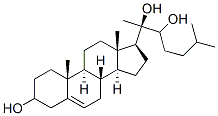Naturally occurring oxysterols are products of cholesterol oxidation that can stimulate the hedgehog (Hh) signaling pathway in target cells associated with cardiovascular disease and with bone formation. Depending on the target cell, activation of Hh signaling can modulate inflammatory responses to additional atherogenic factors such as lesion-producing macrophages or enable osteoblast differentiation. Oxy-16 is a synthetic oxysterol compound that may function as an antagonist of hedgehog activity. Published data regarding its efficacy remains forthcoming.
A metabolite of Cholesterol (C432501). Cholesterol is metabolized to Pregnenolone by way of 22R-hydroxycholesterol and 20R,22R-dihydroxycholesterol by P 450scc.
ChEBI: An oxysterol that is cholesterol substituted by hydroxy groups at positions 20 and 22 (the 20R,22R-stereoisomer).
oxysterols have been shown to be associated with immunosuppression, apoptosis, atherosclerosis, inflammation, and cholesterol turnover. other studies aslo indicated that oxysterols were hedgehog (hh) signaling pathway activators and had potent osteoinductive properties. oxy-16, an oxysterol, was identified as a cell permeable oxygenated derivative of cholesterol that might be the end product or intermediate of the cholesterol excretion pathways. oxy-16 is currently used as a transport form for cholesterol across the blood brain barrier and membranes. the osteogenic differentiation caused by oxy-16 was cinsidered to be mediated via a wnt signaling-related, dkk-1-inhibitable mechanism [1].
[1] amantea, c. m.,kim, w.k.,meliton, v., et al. oxysterol-induced osteogenic differentiation of marrow stromal cells is regulated by dkk-1 inhibitable and pi3-kinase mediated signaling. journal of cellular biochemistry 105(2), 424-436 (2008).
